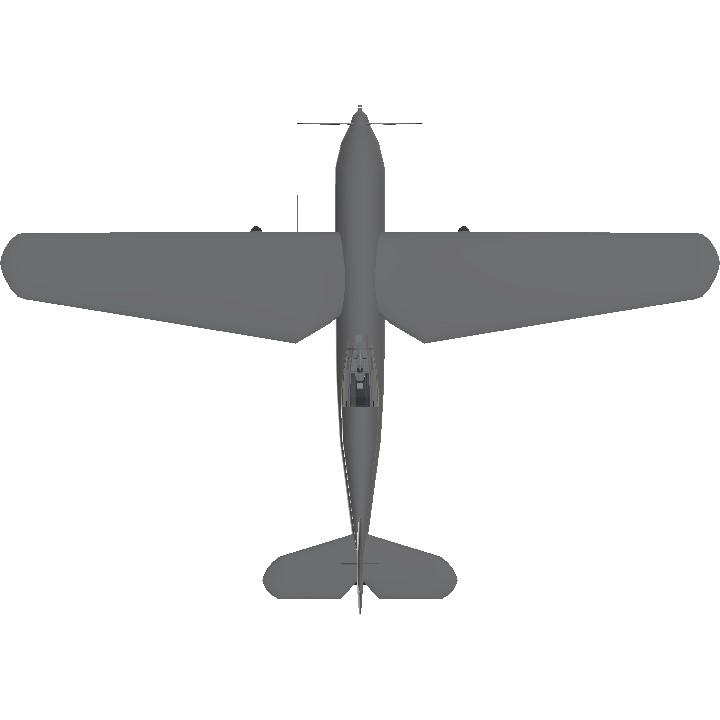Description
The Ikarus IK-2 was a Yugoslav single-engine, single-seat monoplane fighter designed and built by the Ikarus aircraft manufacturer in the 1930s. It was one of the first monoplane fighters developed in Yugoslavia, representing a significant advancement in the country’s aviation capabilities.
Design and Development
Designer: The IK-2 was designed by a team led by engineers Kosta Sivcev and Ljubomir Ilic.
First Flight: The prototype of the IK-2, designated as IK-L1, first flew in April 1935.
Structure: Though initially intended to be a low-wing fighter with retracting landing gear, due to fierce opposition from many Air Force officers and pilots who favored the old biplane design, this new concept had to be abandoned at an early stage of development. The two engineers then decided to proceed with a high semi-cantilevered wing design.
Stability: Due to it's configuration with the cockpit far back in the fuselage in relation to the wings and engine the aircraft tended to pitch forwards at lower speeds but corrected itself at higher speeds or using it's trim controls.
Powerplant: Hispano-Suiza 12Ycrs liquid-cooled V-12 piston engine, 640 kW (860 shp)
Armament: 2, 7.92 mm Browning/FN machine guns underneath the cilinders and to the sides of the engine and a single 20 mm Hispano-Suiza HS.9 cannon mounted between the engine cylinders and firing through the propeller hub.
In War

When the war broke out on the 6th April 1941 the 4th Fighter Regiment had only 8 fully operational aircraft ready for service. Four IK-2’s suffered from mechanical breakdowns and were undergoing repairs at Zemun and Zagreb workshops. Author Z. Rendulic mentioned that only 10 IK-2 were available.

In addition, the 4th Regiment had 18 to 20 Hawker Hurricanes, making this unit among the most up-to-date in the RYAF(Royal Yugoslav Air Force). On the first day of the war, the IK-2 was mainly used for reconnaissance. The following day, two IK-2s tried to bring down a German reconnaissance aircraft but failed to do so. One IK-2 would be lost, possibly due to mechanical breakdown. The first proper combat engagement of the IK-2 occurred on the 9th of April when during reconnaissance, a group of some 23 Bf 109 were spotted. While one IK-2 had to land to refuel, the second one provided a delayed action in hopes of giving the 4th Fighter Regiment enough time to muster its available fighters. Shortly after, some 5 or 6 IK-2 and 8 Mk.I Hurricanes joined the fight. The German fighters were attacking in well-coordinated groups, protecting each other, while the Yugoslav fighters entered the battle in a somewhat disorganized manner. After a fierce skirmish that lasted some 10 minutes, the Germans broke off and retreated back to their base of operations in Austria. The Germans lost two aircraft, while the Yugoslavians lost three, one IK-2 and two Hurricanes. In the next few days, engagements with the enemy were rare, but the IK-2 managed to shoot down one Ju 88, in addition to two other Luftwaffe aircraft.
The 4th Regiment would meet its fate on the 14th of April when the pilots decided to destroy their remaining aircraft in order to prevent them from falling into enemy hands. Despite their attempts, the Germans managed to capture one slightly damaged IK-2 belonging to the 4th Fighter Regiment. Four additional aircraft were acquired when the repair workshops in Zagreb and Belgrade were captured. Some internet sources noted that up to 9 aircraft were captured by the Germans, but this seems highly unlikely and that the number of 5 is probably correct.
While a number of IK-2 were lost due to mechanical failures, the majority would be destroyed by their own crews to prevent them from being captured by the Germans.
Afterword
It is quite a shame that these old monoplanes have so little coverage and were used so poorly when they indeed outperformed their biplane counterparts
I found 3 videos on the aircraft, at least that were not about their miniature models
Still i find it a beautiful plane, and quite goofy as many of the interwar birds were
I hope everyone enjoys flying it as much as i did building it
ah, and careful with the propeller on takeoff
Specifications
Spotlights
- Trainzo one year ago
- KimuNemuru one year ago
General Characteristics
- Predecessor Inter-War Fighter Challenge [Open]
- Created On Windows
- Wingspan 35.9ft (11.0m)
- Length 25.5ft (7.8m)
- Height 10.8ft (3.3m)
- Empty Weight 5,193lbs (2,355kg)
- Loaded Weight 6,511lbs (2,953kg)
Performance
- Horse Power/Weight Ratio 0.122
- Wing Loading 34.3lbs/ft2 (167.3kg/m2)
- Wing Area 190.0ft2 (17.7m2)
- Drag Points 910
Parts
- Number of Parts 213
- Control Surfaces 7
- Performance Cost 899







nice plane
GREAT build and very nice screens .